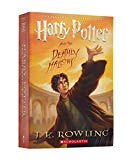
Harry Potter and the Dealthy Hallows is the seventh and final book in J.K. Rowlings Harry Potter series. Voldemort is continuing to accumulate power and it is up to Harry, Ron, and Hermoine to find the remaining Horcruxes to defeat him once and for all. When the Death Eaters descend upon Hogwarts, it leads to a battle that will affect the future of the wizarding world forever.
In a 2006 interview, J. K. Rowling said that the main theme of the series is Harry dealing with death, which was influenced by her mother's death in 1990, from multiple sclerosis. Lev Grossman of Time stated that the main theme of the series was the overwhelming importance of continuing to love in the face of death.
Academics and journalists have developed many other interpretations of themes in the books, some more complex than others, and some including political subtexts. Themes such as normality, oppression, survival, and overcoming imposing odds have all been considered as prevalent throughout the series. Similarly, the theme of making one's way through adolescence and "going over one's most harrowing ordeals—and thus coming to terms with them" has also been considered. Rowling has stated that the books comprise "a prolonged argument for tolerance, a prolonged plea for an end to bigotry" and that also pass on a message to "question authority and ... not assume that the establishment or the press tells you all of the truth".
Some political commentators have seen J. K. Rowling's portrayal of the bureaucratised Ministry of Magic and the oppressive measures taken by the Ministry in the later books (like making attendance at Hogwarts School compulsory and the "registration of Mudbloods" with the Ministry) as an allegory of criticising the state.
The Harry Potter series has been criticised for supposedly supporting witchcraft and the occult. Before publication of Deathly Hallows , Rowling refused to speak out about her religion, stating, "If I talk too freely, every reader, whether 10 or 60, will be able to guess what's coming in the books". However, many have noted Christian allegories apparent in Deathly Hallows . For example, Harry dies and then comes back to life to save mankind, like Christ. The location where this occurs is King's Cross. Harry also urges Voldemort to show remorse, to restore his shattered soul. Rowling also stated that "my belief and my struggling with religious belief ... I think is quite apparent in this book", which is shown as Harry struggles with his faith in Dumbledore.
Deathly Hallows begins with a pair of epigraphs, one by Quaker leader William Penn and one from Aeschylus' The Libation Bearers . Of this, Rowling said "I really enjoyed choosing those two quotations because one is pagan, of course, and one is from a Christian tradition. I'd known it was going to be those two passages since Chamber was published. I always knew [that] if I could use them at the beginning of book seven then I'd cued up the ending perfectly. If they were relevant, then I went where I needed to go. They just say it all to me, they really do".
When Harry visits his parents' grave, the biblical reference "The last enemy that shall be destroyed is death" (1 Corinthians 15:26) is inscribed on the grave. The Dumbledores' family tomb also holds a biblical quote: "Where your treasure is, there your heart will be also", which is from Matthew 6:21. Rowling states, "They're very British books, so on a very practical note Harry was going to find biblical quotations on tombstones ... [but] I think those two particular quotations he finds on the tombstones at Godric's Hollow, they sum up– they almost epitomise the whole series".
Harry Potter pundit John Granger additionally noted that one of the reasons the Harry Potter books were so popular is their use of literary alchemy (similar to Romeo and Juliet , C. S. Lewis's Perelandra and Charles Dickens's A Tale of Two Cities ) and vision symbolism. In this model, authors weave allegorical tales along the alchemical magnum opus. Since the medieval period, alchemical allegory has mirrored the passion, death and resurrection of Christ. While the entire series utilises symbols common in alchemy, the Deathly Hallows completes this cycle, tying themes of death, rebirth, and the Resurrection Stone to the principal motif of alchemical allegory, and topics presented in the first book of the series.
Already have an account? Log In Now